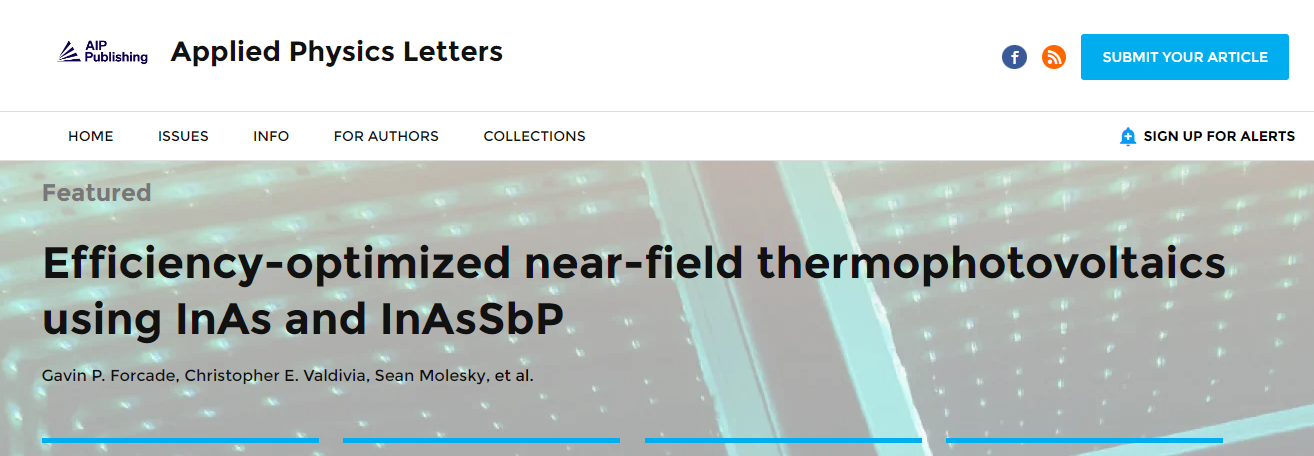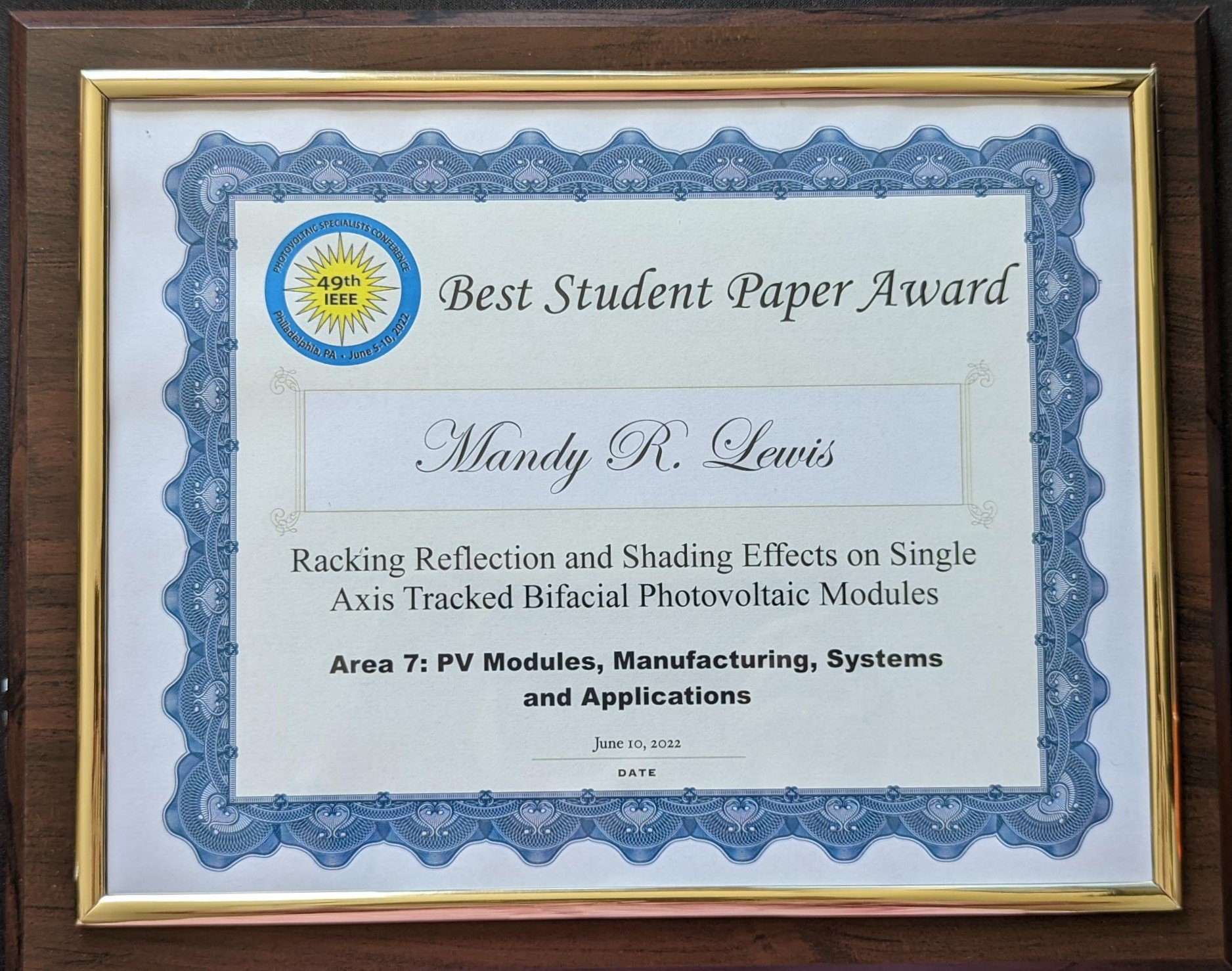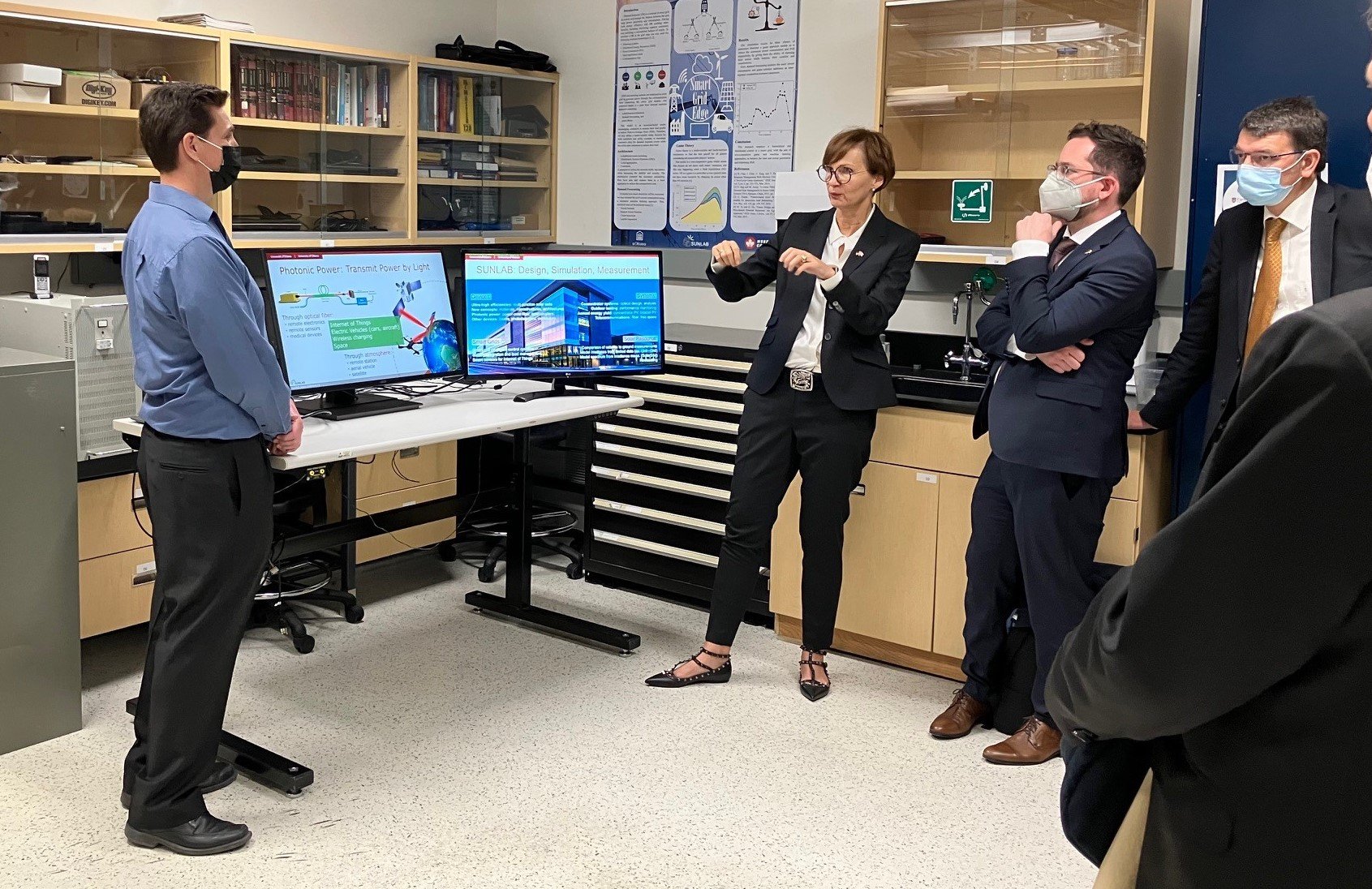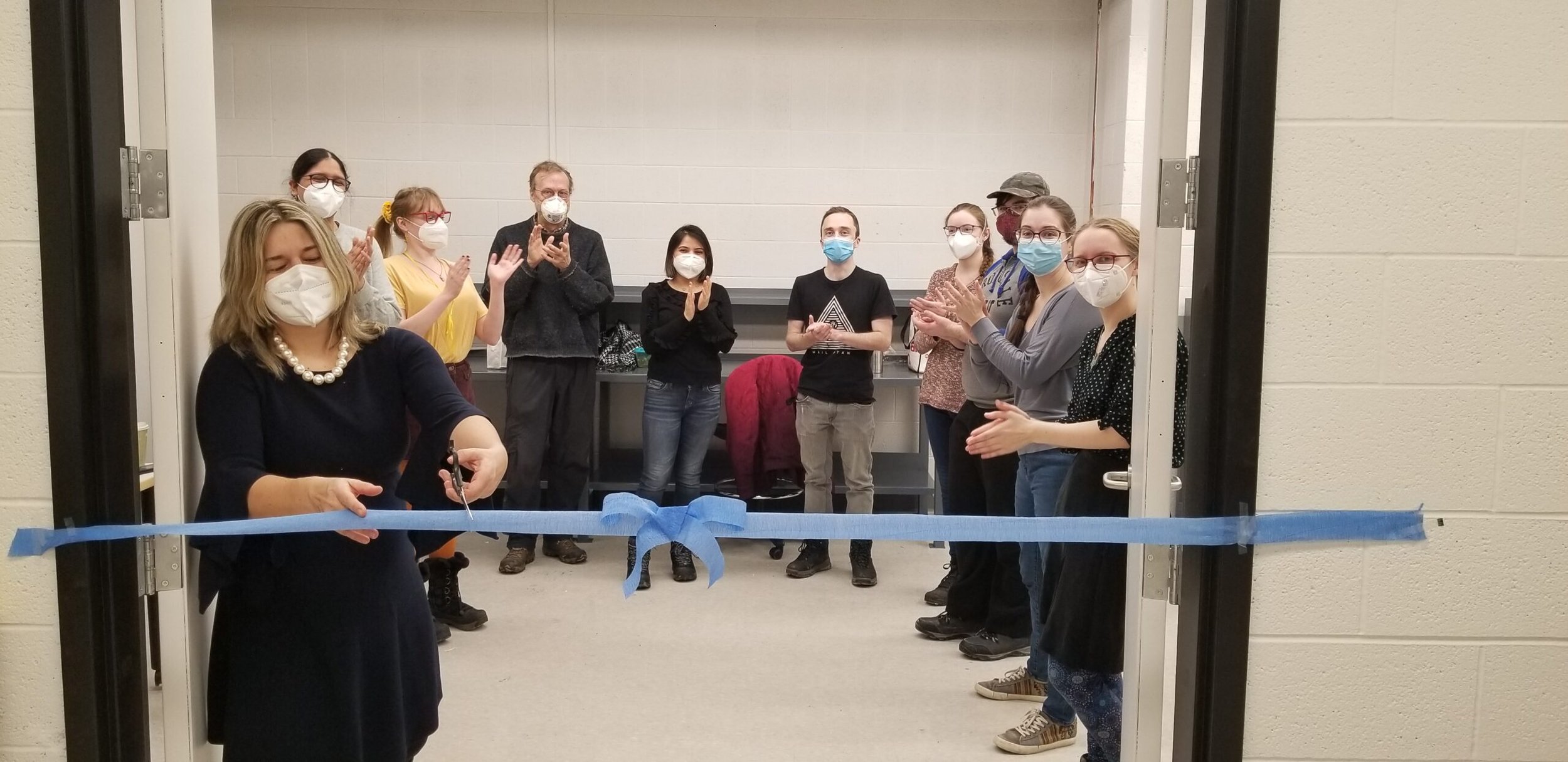
SUNLAB News
New Publication from the SUNLAB: Optics Express
SUNLAB has published a new paper in Optics Express, first-authored by MASc candidate Trevor Coathup. This paper quantifies the impact of torque tube reflections in tracked bifacial photovoltaic systems over a typical meteorological year in Livermore, California, USA.
Among the racking elements of bifacial photovoltaic single-axis tracked systems, the torque tube introduces the most shading and reflection, increasing irradiance nonuniformity and electrical mismatch loss. Ray tracing bifacial PV modeling software can capture these effects at a high computational cost, and two-dimensional or three-dimensional view factor models can estimate their impacts with shading factors to iterate through simulations more quickly. DUET, SUNLAB's three-dimensional view factor model, which accounts for detailed shading using ray-object intersection, can be expanded to include reflections from racking elements, specifically the torque tube, and balance the accuracy-computational intensity tradeoff.
We simulate the impact of torque tube reflection on irradiance, electrical mismatch, and total energy yield based on sun position and sky condition for central bifacial photovoltaic modules on one-in-portrait (1P) and two-in-portrait (2P) single-axis trackers. We extract the torque tube reflection using a ray tracing model and introduce it as an additional irradiance source in DUET to assess the impact of torque tube reflection in such a model.
Despite the gap between modules allowing for more incident illumination on the torque tube in the 2P system, the relative impact of the torque tube reflection is similar, and can be larger in the 1P system for low irradiance conditions. Torque tube reflection increases annual irradiance in 1P and 2P systems by 0.17% and 0.30%, respectively. Overall, torque tube reflection increases the predicted instantaneous energy yield by up to 0.8% and 0.4%, and the annual energy yield by 0.11% and 0.18% in 1P and 2P system, respectively.
Click here for the full article.
T. J. Coathup, M. R. Lewis, A. C. J. Russell, J. E. Haysom, C. E. Valdivia, and K. Hinzer, Impact of torque tube reflection on bifacial photovoltaic single axis tracked system performance, Optics Express 31(4) (2023). DOI: 10.1364/OE.481301
New Publication from the SUNLAB: Applied Physics Letters
In a new paper published in Applied Physics Letters, recent SUNLAB graduate Ras-Jeevan Obhi, MASc, and a collaborative team between SUNLAB and National Research Council Canada researchers, have studied how quantum dash morphology and composition can be used to tune the emission wavelength of semiconductor quantum dash lasers. This analysis of nanoparticle arrays using atomic force microscopy and simulations of single quantum dashes provides valuable information for future designs of quantum dash lasers emitting at 1550 nm for next generation optical networks. This work is part of the TERAQD project, which is funded by the High-throughput and Secure Networks Challenge Program from National Research Council Canada.
Click here for the full article.
R.-J. K. Obhi, S. W. Schaefer, C. E. Valdivia, J. R. Liu, Z. G. Lu, P. J. Poole, and K. Hinzer, Indium arsenide single quantum dash morphology and composition for wavelength tuning in quantum dash lasers, Appl. Phys. Lett. 122(051104) (2023). DOI: 10.1063/5.0133657
New Publication from the SUNLAB: Joule
SUNLAB researchers have developed a new method for measuring the solar energy produced by bifacial solar panels, the double-sided solar technology which is expected to meet increased global energy demands moving forward.
Published in the journal Joule, this study from the SUNLAB team in the Faculties of Engineering and Science proposes a characterization method that will improve the measurement of bifacial panels indoors by considering external effects of ground cover such as snow, grass and soil. This will provide a way to consistently test bifacial solar panel performance indoors that accurately represents how the panels will perform outdoors.
With bifacial photovoltaics expected to provide over 16% of global energy demand by 2050, the SUNLAB’s methodology will improve international device measurement standards which currently do not distinguish between ground cover.
“Our proposed characterization method, the scaled rear irradiance method, is an improved method for indoor-measuring and modelling of bifacial devices that is representative of outdoor environmental conditions,” explains Erin Tonita, lead author and a Physics PhD student studying under Professor Karin Hinzer, whose research involves developing new ways to harness the sun’s energy.
“Incorporating this new method into future bifacial standards would provide a consistent methodology for testing bifacial panel performance under ground conditions including snow, grass, and soil, corresponding to globally varying illumination conditions.”
Photovoltaics is the study of converting solar energy into electricity through semiconducting materials, such as silicon. In bifacial solar panels, the semiconducting material is wedged between two sheets of glass to allow for sunlight collection on both sides, with one side typically angled towards the sun and the other side angled towards the ground. The additional light collected by bifacial solar panels on the rear-side offers an advantage over traditional solar panels, with manufacturers touting up to a 30% increase in production compared to traditional solar panels. Bifacial solar panels are also more durable than traditional panels and can produce power for over 30 years.
"Implementation of this method into international standards for such panels can enable predictions of outdoor bifacial panel performance to within 2% absolute”, says Tonita, who expects the benefits of this methodology to include:
Allowing comparisons between existing and emerging bifacial technologies.
Enhancing performance via ground cover specific design optimization.
Increasing solar panel deployments in non-traditional markets.
Reducing investment risk in bifacial panel deployments.
Improving bifacial panel manufacture datasheets.
“This method is of particular importance as renewable energy penetration increases towards a net-zero world, with bifacial photovoltaics projected to contribute over 16% of the global energy supply by 2050, or around 30,000 TWh annually,” says Hinzer, founder of SUNLAB and the University Research Chair in Photonic Devices for Energy and a Professor at the School of Electrical Engineering and Computer Science.
“This will extend current International Electrochemical Commission standards for bifacial solar panel measurements, enabling accurate comparisons of bifacial panel technologies, application-specific optimization, and the standardization of bifacial panel power ratings,” adds Hinzer, whose SUNLAB researchers worked in collaboration with Arizona State University for the study.
Housed at the University of Ottawa’s Centre for Research in Photonics, SUNLAB is the premier Canadian modelling and characterization laboratory for next generation bifacial, multi-junction, and concentrator solar devices.
E. M. Tonita, C. E. Valdivia, A. C. J. Russell, M. Martinez-Szewczyk, M. I. Bertoni, and K. Hinzer, A general illumination method to predict bifacial photovoltaic system performance, Joule 7(1), 5-12 (2023). DOI: 10.1016/j.joule.2022.12.005
In the media:
U of O researcher suggests novel measuring method for bifacial solar panels, The Fulcrum, September 21, 2023
Dwustronne panele fotowoltaiczne. Kolejny przełom w rozwoju słonecznej energii?, Świat OZE, February 6, 2023
Nouvelle méthode pour mesurer le rendement énergétique des systèmes PV bifaciaux, pv magazine, January 27, 2023
Nouvelle méthode pour mesurer avec précision la puissance des panneaux solaires à double face, Enerzine, January 25, 2023
New method to measure energy yield of bifacial PV systems, pv magazine, January 23, 2023
Double-sided solar panel breakthrough offers big boost for net-zero targets, Independent, January 18, 2023
Double-sided solar panel breakthrough offers big boost for net-zero targets, Yahoo!News, January 18, 2023
Double-sided solar panel breakthrough offers big boost for net-zero targets, MSN, January 18, 2023
Harnessing solar energy: New method improves readings of double-sided panels, Renewable Energy Magazine, January 18, 2023
Harnessing solar energy: New method improves readings of double-sided panels, ScienMag, January 18, 2023
Harnessing solar energy: New method improves readings of double-sided panels, TechNewsBoy, January 18, 2023
Harnessing solar energy: New method improves readings of double-sided panels, University of Ottawa Media, January 18, 2023
SUNLAB PhD Physics Student Erin Tonita, lead author of the new Joule publication.
SUNLAB Energy Futures Forum Celebrates 1 Year
In September, our Energy Futures Forum (EFF) celebrated it’s first birthday! SUNLAB students have been reading up on pathways to net-zero emissions and other topics in renewables integration, climate policy, and energy justice. We get together every couple of months to share, discuss, and ask questions. You can see some of the topics we’ve covered below:
- IEA Transport Emissions Summaries
- Embodied Carbon of PV
- Energy Subsidies in Canada and around the world
- Carbon Capture, Utilization and Storage
- IEA Net Zero by 2050 Report
- Fed. Gov. 2030 Emissions Reduction Plan
- NREL/DOE Solar Futures Study
- COP26 Emissions Targets by Country
- 2021 Federal Election Platforms on Energy/Climate
The EFF is winding down for the winter break, but we’ll be back in the new year!
New Publication from the SUNLAB: IEEE Journal of Photovoltaics
SUNLAB has published a new paper in IEEE Journal of Photovoltaics, first-authored by postdoctoral fellow Dr. Meghan Beattie. In collaboration with researchers at the Fraunhofer Institute for Solar Energy Systems ISE in Germany, the SUNLAB team studied two highly efficient O-band photonic power converter designs, demonstrating their potential for powering devices requiring less than 250 mW with an appropriate illumination profile. This work is part of the AIIR-Power (Artificial Intelligence Enhanced Design and Manufacturing of Infrared Photonic Power Converters for Power and Telecom) project, a German-Canadian collaborative effort funded by the German Federal Ministry of Education and Research and the National Research Council of Canada
Abstract: Photonic power converters (PPCs), which convert narrow-band light to electricity, are essential components in power-by-light systems. When designed for telecommunications wavelengths such as the O-band, near 1310 nm, the devices are well-suited to power-over-fiber applications. Despite the potential for very high power conversion efficiencies ( >50% ), PPCs can be adversely affected by high-intensity nonuniform illumination conditions. In this work, we characterized two O-band PPC designs based on: high-quality InGaAsP absorber material lattice-matched to an InP substrate, and metamorphic InGaAs absorber material lattice-mismatched to a GaAs substrate, a more cost-effective and scalable alternative. We measured each device under O-band laser illumination with five beam profiles having peak-to-average ratios ranging from 2 to 11. Both devices were insensitive to the beam uniformity for input illumination with average irradiance below 2 W/cm2 over their 5.4-mm2 active areas, but exhibited better open-circuit voltages under larger, more uniform illumination profiles at higher incident powers. Measured efficiencies reached 52.8% and 48.7% for the lattice-matched and mismatched devices, respectively. Distributed circuit modeling results suggested that both lateral conduction losses and localized heating effects were responsible for the measured dependence on beam-size. Our work demonstrates the potential for O-band PPCs, presenting two highly efficient designs suitable for powering devices requiring ≲250 mW, with an appropriate illumination profile.
Click here for the full article.
M. N. Beattie, H. Helmers, G. P. Forcade, C. E. Valdivia, O. Höhn, and K. Hinzer, InP- and GaAs-based photonic power converters under O-band laser illumination: Performance analysis and comparison, IEEE J. Photovolt. (2022). DOI: 10.1109/JPHOTOV.2022.3218938
SUNLAB research associate wins 3rd place at TiE Ottawa PitchFest
Congratulations to SUNLAB research associate Kibby Pollak on winning 3rd place at the TiE Ottawa PitchFest 2022 held as part of TieCon Canada 2022, October 27 and 28, 2022. Kibby is the founder of MyPITBOARD, an on-board real-time feedback system for motocross racing. Twenty-two companies were competing as part of TiE Ottawa PitchFest 2022. The top five companies qualified for the finals which consisted in a seven-minute presentation judged by Canada's most active investors in front of approximately 150 people. MyPITBOARD received 3rd place. Congratulations Kibby!
New Publication from the SUNLAB: Applied Physics Letters
Congratulations to SUNLAB researchers, including lead author PhD candidate Gavin Forcade, and their collaborators at Princeton University and École polytechnique de Montréal, on their newest publication which was selected as Featured in Applied Physics Letters.
Waste heat is a free and abundant energy source, with 15% of global total energy use existing as waste heat above 600 K. For 600–900K temperature range, near-field thermophotovoltaics (NFTPVs) are theorized to be the most effective technology to recycle waste heat into electrical power. However, to date, experimental efficiencies have not exceeded 1.5%.
In this new work, researchers optimized the efficiency of three modeled InAs/InAsSbP-based room-temperature NFTPV devices positioned 0.1 µm from a 750 K p-doped Si radiator. They coupled a one-dimensional fluctuational electrodynamics model for the near field optics to a two-dimensional drift-diffusion model, which they validated by reproducing measured dark current–voltage curves of two previously published InAs and InAsSbP devices. The optimized devices showed four to six times higher above-bandgap energy transfer compared to the blackbody radiative limit, yielding enhanced power density, while simultaneously lowering parasitic sub-bandgap energy transfer by factors of 0.68–0.85. Substituting InAs front- and back-surface field layers with InAsSbP show 1.5- and 1.4-times higher efficiency and power output, respectively, from lowered parasitic diffusion currents. Of their three optimized designs, the best performing device has a double heterostructure with an n–i–p doping order from front to back. For radiator-thermophotovoltaic gaps of 0.01–10 µm and radiators within 600–900 K, this device has a maximum efficiency of 14.2% and a maximum power output of 1.55 W/cm2, both at 900 K. Within 600–900 K, the efficiency is always higher with near- vs far-field illumination; the team calculated up to 3.7- and 107-times higher efficiency and power output, respectively, using near-field heat transfer.
Click here for the full article.
G. P. Forcade, C. E. Valdivia, S. Molesky, S. Lu, A. W. Rodriguez, J. J. Krich, R. St-Gelais, and K. Hinzer, Efficiency-optimized near-field thermophotovoltaics using InAs and InAsSbP, Appl. Phys. Lett. 121(193903) (2022). DOI: 10.1063/5.0116806
NSERC CREATE TOP-SET Summer School at uOttawa
The NSERC CREATE TOP-SET program held its summer school at the University of Ottawa from July 18 to 20, 2022. A total of 51 participants hailing from academia, government laboratories and industry took part in the three-day program on the theme of "Getting together towards net-zero solutions". Guest speakers from Canada and the United States discussed subjects relevant to TOP-SET trainees including photovoltaic technologies, policy, entrepreneurship and strategic thinking.
Awards were given to the best student poster and oral presentations. Ms. Paramita Bhattacharyya won first place in the oral presentation competition for her talk on “Design and fabrication of color-generating nitride based thin-film optical filters for photovoltaic applications”. Ms. Bhattacharyya is a PhD candidate in engineering physics under the supervision of Dr. Rafael Kleiman at McMaster University. Mr. Nick Anderson won the best poster presentation award. He is a MASc candidate in electrical engineering under the supervision of Dr. Henry Schriemer at the University of Ottawa. He presented a poster entitled "Probabilistic assessment of narrowband vs broadband solar irradiance temporal variability in Ottawa". Congratulations to all!



uOttawa Institute for Science, Society and Policy Blog Post from SUNLAB Postdoctoral Fellow
As part of a collaboration between the SUNLAB and the University of Ottawa Institute for Science, Society and Policy, SUNLAB postdoctoral fellow Meghan Beattie recently published a blog post exploring how scientists and engineers can help to build public support on Canada's path to net zero by sharing their expertise. In her post, Dr. Beattie describes the energy information landscape, outlines current challenges with public confidence in expert opinion, and identifies pathways for the science and engineering community to address the need for reliable and accessible information to reach public authorities and the public at large.
Click here to read her post.
M. Beattie, How scientists & engineers can share Information to help build public support on Canada’s path to net zero emissions, University of Ottawa Institute for Science, Society and Policy Blog (2022). https://issp.uottawa.ca/en/news/how-scientists-engineers-can-share-information-help-build-public-support-canadas-path-net-zero. (Retrieved July 21, 2022)
New Publication from the SUNLAB: IEEE Journal of Photovoltaics
SUNLAB has published a new paper in IEEE Journal of Photovoltaics, first-authored by PhD candidate Annie Russell. This paper details a multi-year project developing a software platform called DUET (Dual-sided Energy Tracer), which calculates performance of photovoltaic modules and systems under a wide range of geometrical, electrical, and environmental conditions to incorporate detailed irradiance profiles resulting in highly accurate energy yields and other performance metrics.
Abstract: Bifacial photovoltaic (PV) performance models strive to accurately quantify rear-incident irradiance. While ray tracing models are optically rigorous, they require significant computational resources; faster view factor (VF) models are widely adopted but require user-defined loss factors to approximate rear shading and irradiance nonuniformity, introducing uncertainty in energy yield predictions. This article describes DUET—a bifacial PV performance model that calculates optical and electrical performance based on a physically representative array geometry. DUET's novel shading algorithm pairs a 3-D VF model with deterministic ray-object intersections to capture 2-D shade-inclusive irradiance profiles while minimizing computational cost. Series and parallel combination of current–voltage curves capture irradiance nonuniformity throughout the module and array. This article provides validation against open-access system measurements from a test site in Roskilde, Denmark, and comparison to other software tested there. DUET's modeled bifacial energy yield agrees with measured data within −1.56% for fixed-tilt and −0.65% for horizontal single-axis tracked (HSAT) systems. Mean absolute error (MAE) in hourly bifacial power is 14.2–15.0 mW/Wp for fixed-tilt and 17.3–18.3 mW/Wp for HSAT, depending on the module temperature model applied. Comparing modeled and measured rear irradiance of two rear-facing pyranometers, DUET's MAE values of 2.8 W/m2 for fixed-tilt and 3.7 W/m2 for HSAT are among the lowest errors reported for other software tested at this site. DUET provides computationally efficient bifacial performance modeling with geographic, temporal, and structural specificity to determine loss factors for use in other performance models or to be used directly in system design optimization.
Click here for the full article.
A. C. J. Russell, C. E. Valdivia, C. Bohémier, J. E. Haysom, and K. Hinzer, DUET: A novel energy yield model with 3-D shading for bifacial photovoltaic systems, IEEE J. Photovolt. (2022). DOI: 10.1109/JPHOTOV.2022.3185546
SUNLAB at the CanREA Operations Summit
PhD candidate Annie Russell was invited to give a presentation on bifacial photovoltaics modules and systems at the CanREA Operations Summit, which took place in Toronto May 31 and June 1, 2022. See her presentation below.
New Publication from the SUNLAB: Optics Express
In a new paper published in Optics Express earlier this month, lead author PhD candidate Neda Nouri and a team of SUNLAB researchers applied numerical simulations to design and optimize single junction ultra-thin InAlGaAs photonic power converters (PPCs) for operation at the telecommunications wavelength of 1310 nm, incorporating light trapping via integrated back reflectors (BRs) of three types: planar, cubic nano-textured, and pyramidal nano-textured. Compared to conventional thick PPCs on a substrate, modelled ultra-thin PPCs with back reflectors demonstrate up to 12% larger Voc and 10% (relative) larger power conversion efficiency. Of the studied BR designs, pyramidal BRs exhibit the highest performance, reaching an efficiency of 43.2%, while also attaining >8-fold reduction in absorber thickness.
The methodology and results in this paper can inform designs of other wavelength ranges, system configurations, and optical device types for other light-absorbing applications.
Click here for the full article.
N. Nouri, C. E. Valdivia, M. N. Beattie, J. J. Krich, and K. Hinzer, Light management in ultra-thin photonic power converters for 1310 nm laser illumination, Optics Express 30 (13) (2022). DOI: 10.1364/OE.459680
SUNLAB at PVSC
Earlier this month, SUNLAB students and researchers attended the 49th IEEE Photovoltaics Specialists Conference in Philadelphia, PA. Postdoctoral fellows Meghan Beattie and Mathieu de Lafontaine, PhD physics candidates Erin Tonita and Gavin Forcade, PhD electrical engineering candidates Mandy Lewis and Annie Russell, MASc electrical engineering candidate Nick Anderson and our friend from the Krich Lab PhD physics candidate Daisy Xia presented results on a wide range of topics including bifacial photovoltaic system performance and modeling, near-field thermophotovoltaics, solar irradiance temporal variability, photonic power converters and multijunction photovoltaics. For a full list of SUNLAB presentations, see our Conference Presentations page.
Congratulations to:
- Mandy Lewis, for being awarded a Best Student Paper Award for Area 7;
- Annie Russell for a mention in the Monday Daily Highlights;
- Meghan Beattie and Daisy Xia for mentions in the Tuesday Daily Highlights;
- Mandy Lewis, Annie Russell and Erin Tonita for mentions in the Friday Daily Highlights.
The IEEE Photovoltaics Specialists Conference is the longest-running technical gathering for the photovoltaics industry. This year, it was held at the Pennsylvania Convention Center in Philadelphia from June 5 to 10. It marked the return to in-person conferences for SUNLAB members.
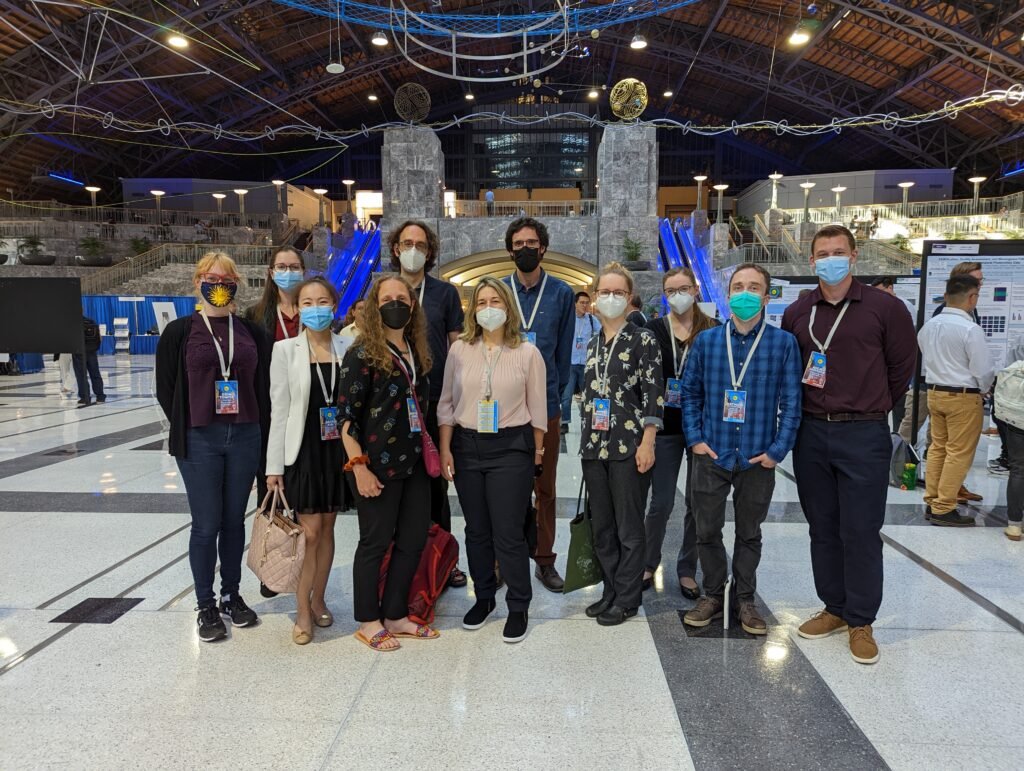
Back row: Erin Tonita, Mandy Lewis, Jacob Krich, Gavin Forcade and Meghan Beattie.
SUNLAB welcomes German federal minister of education and research
SUNLAB researchers and students were delighted to meet German federal minister of education and research Ms. Bettina Stark-Watzinger and her delegates last Thursday, June 9. Ms. Stark-Watzinger visited the SUNLAB facilities where senior research scientist Dr. Chris Valdivia gave an overview of the "Artificial Intelligence Enhanced Design and Manufacturing of Infrared Photonic Power Converters for Power+Telecom" (AIIR-Power) project.
Led by SUNLAB director Dr. Karin Hinzer, AIIR-Power involves researchers from the Fraunhofer Institute for Solar Energy and AIXTRON, based in Germany, as well as the National Research Council of Canada, Optiwave and Broadcom, based in Canada. AIIR-Power aims to develop artificial intelligence techniques to design and manufacture elevated-voltage photonic power converters. It is funded by the "3+2 Canada-Germany Collaborative Industrial Research and Development Program" through the National Research Council of Canada and the German Federal Ministry of Education and Research.
Dr. Chris Valdivia and Ms. Bettina Stark-Watzinger discuss the AIIR-Power project.
Ms. Stark-Watzinger also met with uOttawa Vice-President, Research Dr. Sylvain Charbonneau.
SUNLAB students awarded scholarships
Congratulations to SUNLAB students Nick Anderson, Nicholas Dallaire and Victoria Jancowski on receiving prestigious scholarships to support their research.
MASc electrical engineering candidate Nick Anderson has been awarded a Canada Graduate Scholarship – Master’s program. This scholarship is meant to develop trainee research skills by “supporting students who demonstrate a high standard of achievement in undergraduate and early graduate studies."
MSc physics candidate Nicholas Dallaire has been awarded an Ontario Graduate Scholarship. This merit-based scholarship is available to graduate students in all disciplines of academic study. The Ontario Graduate Scholarships program is jointly funded by the Province of Ontario and Ontario universities.
BASc electrical engineering candidate Victoria Jancowski is spending the summer at the SUNLAB performing research on spectroradiometric standards for bifacial photovoltaic solar power. She has been awarded a CSA Group Undergraduate Research Scholarship, which aims to support undergraduate students in the pursuit of novel research related to standards, and a Faculty of Engineering Women Undergraduate Summer Student Research Award, which is intended to encourage students to pursue graduate studies in engineering or computer science.
References
Natural Sciences and Engineering Research Council of Canada (retrieved June 29, 2022). Canada Graduate Scholarships - Master's program. https://www.nserc-crsng.gc.ca/Students-Etudiants/PG-CS/index_eng.asp
Ontario Student Assistance Program (retrieved June 16, 2022). Ontario Graduate Scholarship (OGS) Program: https://osap.gov.on.ca/OSAPPortal/en/A-ZListofAid/PRDR019245.html
CSA Group (retrieved June 16, 2022). CSA Group Undergraduate Research Scholarship: https://www.csagroup.org/csa-group-undergraduate-research-scholarship/
SUNLAB winter thesis defences
Congratulations to Laurier Baribeau, Robert Pollak and Mikhak Samadi who defended their theses earlier this year! They received their diplomas this week at the spring convocation. You can now find their theses on ruor.uottawa.ca:
Laurier Baribeau, MASc Electrical Engineering, Design of multi-junction solar cells incorporating silicon-germanium-tin alloys with finite-element analysis and drift-diffusion model, DOI: 10.20381/ruor-27436
Robert Pollak, MASc Electrical Engineering, Realizing the energy transition with distributed photovoltaics: A study of high PV penetration grid-edge network dynamics, DOI: 10.20381/ruor-27713
Mikhak Samadi, PhD Electrical Engineering, Data-driven demand management for smart grid, DOI: 10.20381/ruor-27782
New Publications from the SUNLAB: Photonics West Conference Proceedings
Congratulations to MASc candidates Nick Anderson, Trevor Coathup and Ras-Jeevan Obhi for the publication of proceedings following their presentations at SPIE Photonics West. You can download their papers and view their presentations using the links below.
T. J. Coathup, M. R. Lewis, A. C. J. Russell, A. Conesa, J. Guerrero-Perez, C. E. Valdivia, and K. Hinzer, Impact of reflective torque tube on rear side irradiance in bifacial photovoltaic modules, SPIE Photonics West 2022, San Francisco, CA, January 22-27, 2022. DOI: 10.1117/12.2615658, hdl.handle.net/10393/43517
N. Anderson, V. Tatsiankou, K. Hinzer, R. Beal, and H. Schriemer, Probabilistic description of short-term cloud dynamics from rapid sampling of the solar spectral irradiance, SPIE Photonics West 2022, San Francisco, CA, January 22-27, 2022. DOI: 10.1117/12.2616231, hdl.handle.net/10393/43519
R.-J. K. Obhi, S. W. Schaefer, C. E. Valdivia, P. J. Poole, J. Liu, Z. Lu, and K. Hinzer, Height distributions of uncapped InAs/InGaAsP/InP quantum dashes and their effect on emission wavelengths, SPIE Photonics West 2022, San Francisco, CA, January 22-27, 2022. DOI: 10.1117/12.2609954, hdl.handle.net/10393/43518
Ribbon cutting ceremony for SUNLAB new laboratories
Earlier this month, the SUNLAB inaugurated its new laboratories in Colonel By Hall. This new space will be used for research on next generation photovoltaics for smart grid systems. Many SUNLAB students and researchers were on hand to watch SUNLAB director Karin Hinzer cut the ribbon.
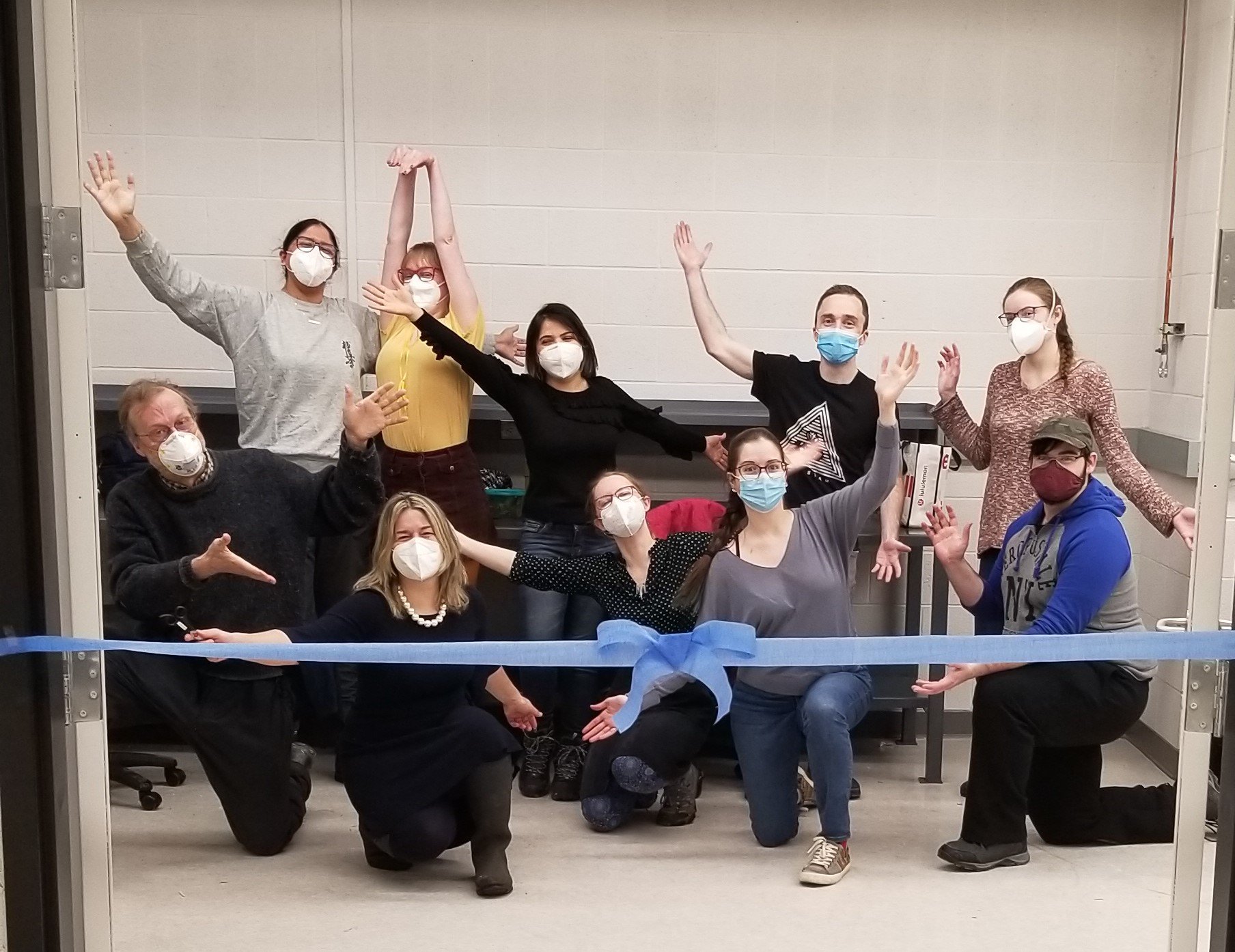
Back row: Ras-Jeevan Obhi, Erin Tonita, Neda Nouri, Mathieu de Lafontaine and Meghan Beattie.
SUNLAB Skating!
SUNLAB members enjoyed the world's largest skating rink on a regular basis this winter.

Back row: Gavin Forcade, Erin Tonita, Ras-Jeevan Obhi, Nick Anderson and Mathieu de Lafontaine.
New Publication from the SUNLAB: Solar Energy Materials and Solar Cells

A recent study led by SUNLAB PhD candidate Erin Tonita in collaboration with Arizona State University’s DEfECT Lab has been published in Solar Energy Materials and Solar Cells. The authors investigated the effect of incident spectra on current loss in high efficiency textured bifacial silicon heterojunction solar cells. They developed an optoelectronic model capable of simulating the response of these cells to a variety of spectral conditions, and validated the model with fabricated cells. They calculated a decrease in parasitic absorption of up to 50% rel. with air mass (AM) increasing from 1.5 to 10 and a slight rise (~0.5% abs.) in c-Si recombination. The combined effect resulted in overall improved cell efficiency up to AM5 for front illumination and rear illumination with unity albedo. When the spectral albedo of dry-grass was considered on the rear face, this resulted in a sharp decrease in efficiency with increased AM, unlike the case of unity albedo.
Overall, current-collection and efficiency trends emphasized the importance of considering spectral effects in energy yield models. As efficiency tends to rise with AM, this will enhance energy yield in mid-to-high latitude locations, which have significant power contributions at high AM.
Rear the full article here in Solar Energy Materials and Solar Cells.
E. M.Tonita, C. E. Valdivia, M. Martinez-Szewczyk, M. R. Lewis, M. I. Bertoni, and K. Hinzer, Effect of air mass on carrier losses in bifacial silicon heterojunction solar cells, Sol. Energy Mater. Sol. Cells. 230(111293) (2021). DOI: 10.1016/j.solmat.2021.111293

